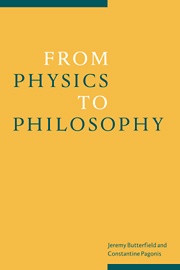Book contents
- Frontmatter
- Contents
- List of contributors
- Preface
- Introduction
- 1 Locality and the Hardy theorem
- 2 Beables in algebraic quantum theory
- 3 Aspects of objectivity in quantum mechanics
- 4 The ‘beables’ of relativistic pilot-wave theory
- 5 Bohmian mechanics and chaos
- 6 Strange positions
- 7 From metaphysics to physics
- 8 Models and mathematics in physics: the role of group theory
- 9 Can the fundamental laws of nature be the results of evolution?
- Bibliography of the writings of Michael Redhead
- Index of names
- Index of subjects
7 - From metaphysics to physics
Published online by Cambridge University Press: 23 December 2009
- Frontmatter
- Contents
- List of contributors
- Preface
- Introduction
- 1 Locality and the Hardy theorem
- 2 Beables in algebraic quantum theory
- 3 Aspects of objectivity in quantum mechanics
- 4 The ‘beables’ of relativistic pilot-wave theory
- 5 Bohmian mechanics and chaos
- 6 Strange positions
- 7 From metaphysics to physics
- 8 Models and mathematics in physics: the role of group theory
- 9 Can the fundamental laws of nature be the results of evolution?
- Bibliography of the writings of Michael Redhead
- Index of names
- Index of subjects
Summary
Introduction
Michael Redhead began his Tarner Lectures by allowing that ‘many physicists would dismiss the sort of question that philosophers of physics tackle as irrelevant to what they see themselves as doing’ (1995, p. 1). He argued that, on the contrary, philosophy has much to offer physics: presenting examples and arguments from many parts of physics and philosophy, he led his audience towards his ultimate conclusion that physics and metaphysics enjoy a symbiotic relationship.
By way of tribute to Michael we would like to undertake a related project: convincing philosophers of physics themselves that the philosophy of space and time has something to offer contemporary physics. We are going to discuss the relationship between the interpretative problems of quantum gravity, and those of general relativity. We will argue that classical and quantum theories of gravity resuscitate venerable philosophical questions about the nature of space, time, and change; and that the resolution of some of the difficulties facing physicists working on quantum theories of gravity appears to require philosophical as well as scientific creativity. These problems have received little attention from philosophers. Indeed, scant attention has been paid to recent attempts to quantize gravity. As a result, most philosophers have been unaware of the problem of time in quantum gravity, and its relationship to the knot of philosophical and technical problems surrounding the general covariance of general relativity – so that it has been all too easy to dismiss this latter set of problems as philosophical contrivances. Consequently, philosophical discussion of space and time has suffered.
This point is best illustrated by attending to the contrast between what philosophers and physicists have to say about the significance of Einstein's hole argument.
- Type
- Chapter
- Information
- From Physics to Philosophy , pp. 166 - 186Publisher: Cambridge University PressPrint publication year: 1999
- 5
- Cited by



